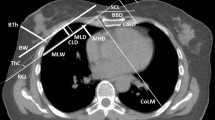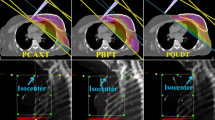Abstract
This study provides a bulk, retrospective analysis of 151 breast and chest wall radiotherapy treatment plans, as a small-scale demonstration of the potential breadth and value of the information that may be obtained from clinical data mining. The treatments were planned at three centres belonging to one organisation over a period of 3 months. All 151 plans were used to evaluate inter-centre consistency and compliance with a local planning protocol. A subset of 79 plans, from one centre, were used in a more detailed evaluation of the effects of anatomical asymmetry on heart and lung dose, the effects of a metallic temporary tissue expander port on dose homogeneity and the overall conformity and homogeneity achieved in routine breast treatment planning. Differences in anatomical structure contouring and nomenclature were identified between the three centres, with all centres showing some non-compliance with the local planning protocol. When evaluated against standard conformity indices, these breast plans performed relatively poorly. However, when evaluated against recommended organ-at-risk tolerances, all evaluated plans performed sufficiently well that tighter planning tolerances could be recommended for future planning. Heart doses calculated in left breast and chest wall treatments were significantly higher than heart doses calculated in right sided breast and chest wall treatments (p < 0.001). In the treatment involving a temporary tissue expander, the inflated implant effectively pushed the targeted breast tissue away from the healthy tissues, leading to a dose distribution that was relatively conformal, although attenuation through the tissue expander’s metallic port may have been underestimated by the treatment planning system. The results of this study exemplify the use of bulk treatment planning data to evaluate clinical workloads and inform ongoing treatment planning.







Similar content being viewed by others
References
Smith FM, Gallagher WM, Fox E, Stephens RB, Rexhepaj E, Petricoin EF 3rd, Liotta L, Kennedy MJ, Reynolds JV (2007) Combination of SELDI-TOF-MS and data mining provides early stage response prediction for rectal tumors undergoing multimodal neoadjuvant therapy. Ann Surg 245(2):259–266
Chen MS, Han J, Yu PS (1996) Data mining: an overview from a database perspective. IEEE Trans Knowl Data Eng 8(6):866–883
Bellazzi R, Zupan B (2008) Predictive data mining in clinical medicine: current issues and guidelines. Int J Med Inf 77(2):81–97
Allozi R, Li XA, White J, Apte A, Tai A, Michalski JM, Bosch WR, Naqa IE (2010) Tools for consensus analysis of experts contours for radiotherapy structure definitions. Radiother Oncol 97(3):572–578
Ebert MA, Haworth A, Kearvell R, Hooton B, Coleman R, Spry N, Bydder S, Joseph D (2008) Detailed review and analysis of complex radiotherapy clinical trial planning data: evaluation and initial experience with the SWAN software system. Radiother Oncol 86(2):200–210
Beetz I, Schilstra C, Burlage FR, Koken PW, Doornaert P, Bijl HP, Chouvalova O, Leemans CR, de Bock GH, Christianen ME, van der Laan BF (2012) Development of NTCP models for head and neck cancer patients treated with three-dimensional conformal radiotherapy for xerostomia and sticky saliva: the role of dosimetric and clinical factors. Radiother Oncol 105(1):86–93
Tsang Y, Ciurlionis L, Clark C, Venables K (2013) Development of a novel treatment planning test for credentialing rotational intensity-modulated radiotherapy techniques in the UK. Br J Radiol 86(1022):20120315
Maggio A, Carillo V, Cozzarini C, Perna L, Rancati T, Valdagni R, Gabriele P, Fiorino C (2013) Impact of the radiotherapy technique on the correlation between dose-volume histograms of the bladder wall defined on MRI imaging and dose-volume/surface histograms in prostate cancer patients. Phys Med Biol 58(7):N115–N123
Williams M, Bailey M, Forstner D, Metcalfe PE (2007) Multicentre quality assurance of intensity modulated radiation therapy plans: a precursor to clinical trials. Australas Radiol 51(5):472–479
Sanchez-Nieto B, Nahum A (2000) BIOPLAN: software for the biological evaluation of radiotherapy treatment plans. Med Dosim 25(2):71–76
Zhao B, Joiner MC, Orton CG, Burmeister J (2010) “SABER”: a new software tool for radiotherapy treatment plan evaluation. Med Phys 37(11):5586–5592
Breen SL, Zhang B (2010) Audit of an automated checklist for quality control of radiotherapy treatment plans. Radiother Oncol 97(3):579–584
Crowe SB, Kairn T, Middlebrook N, Hill B, Christie DR, Knight RT, Kenny J, Langton CM, Trapp JV (2013) Retrospective evaluation of dosimetric quality for prostate carcinomas treated with 3D conformal, intensity modulated and volumetric modulated arc radiotherapy. J Med Radiat Sci 60(4):131–138
Gintz D, Latifi K, Caudell J, Nelms B, Zhang G, Moros E, Feygelman V (2016) Initial evaluation of automated treatment planning software. J Appl Clin Med Phys 17(3):331–346
Kairn T, Crowe S, Kenny J, Knight R, Trapp J (2014) Predicting the likelihood of QA failure using treatment plan accuracy metrics. J Phys Conf Ser 489(1):012051
Crowe S, Kairn T, Kenny J, Knight R, Hill B, Langton CM, Trapp J (2014) Treatment plan complexity metrics for predicting IMRT pre-treatment quality assurance results. Australas Phys Eng Sci Med 37(3):475–482
Crowe SB, Kairn T, Middlebrook N, Sutherland B, Hill B, Trapp J (2015) Evaluation of IMRT and VMAT pre-treatment quality assurance using portal dosimetry. Phys Med Biol 60(6):2587–2601
Australian Institute of Health and Welfare (2014) Australian cancer incidence and mortality (ACIM) books: breast cancer. AIHW, Canberra
Landberg T, Chavaudra J, Dobbs H et al (1999) ICRU report 62 prescribing, recording and reporting photon beam therapy (supplement to ICRU report 50). International Commission on Radiotherapy Units and Measurements, Bethesda
Stewart F, Hoving S, Russell N (2010) Vascular damage as an underlying mechanism of cardiac and cerebral toxicity in irradiated cancer patients. Radiat Res 174(6b):865–869
Nilsson G, Holmberg L, Garmo H, Duvernoy O, Sjogren I, Lagerqvist B, Blomqvist C (2012) Distribution of coronary artery stenosis after radiation for breast cancer. J Clin Oncol 30(4):380–386
Darby SC, Ewertz M, McGale P, Bennet AM, Blom-Goldman U, Brnnum D, Correa C, Cutter D, Gagliardi G, Gigante B, Jensen MB (2013) Risk of ischemic heart disease in women after radiotherapy for breast cancer. N Engl J Med 368(11):987–998
Bouillon K, Haddy N, Delaloge S, Garbay JR, Garsi JP, Brindel P, Mousannif A, Le MG, Labbe M, Arriagada R, Jougla E (2011) Long-term cardiovascular mortality after radiotherapy for breast cancer. J Am Coll Cardiol 57(4):445–452
Spear SL, Majidian A (1998) Immediate breast reconstruction in two stages using textured, integrated valve tissue expanders and breast implants: a retrospective review of 171 consecutive breast reconstructions from 1989 to 1996. Plast Reconstr Surg 101(1):53–63
Kairn T, Crowe S, Fogg P, Trapp J (2013) The appearance and effects of metallic implants in CT images. Australas Phys Eng Sci Med 36(2):209–217
Donovan E, Bleakley N, Denholm E, Evans P, Gothard L, Hanson J, Peckitt C, Reise S, Ross G, Sharp G, Symonds-Tayler R (2007) Randomised trial of standard 2D radiotherapy (RT) versus intensity modulated radiotherapy (IMRT) in patients prescribed breast radiotherapy. Radiother Oncol 82(3):254–264
Donovan E, Yarnold J, Adams E, Morgan A, Warrington A, Evans P (2014) An investigation into methods of IMRT planning applied to breast radiotherapy. Br J Radiol 81(964):311–322
Crowe S, Kairn T, Fielding AL (2009) The development of a Monte Carlo system to verify radiotherapy treatment dose calculations. Radiother Oncol 92:S71
Crowe SB, Kairn T, Trapp JV, Fielding AL (2012) Experimental evaluation of MCDTK, the Monte Carlo DICOM tool-kit. IFMBE Proc 39:1807–1810
Emami B, Lyman J, Brown A, Cola L, Goitein M, Munzenrider J, Shank B, Solin L, Wesson M (1991) Tolerance of normal tissue to therapeutic irradiation. Int J Radiat Oncol Biol Phys 21(1):109–122
Hansen EK, Roach M (2007) Handbook of evidence-based radiation oncology. Springer, New York
Shaw E, Scott C, Souhami L, Dinapoli R, Kline R, Loeffler J, Farnan N (2000) Single dose radiosurgical treatment of recurrent previously irradiated primary brain tumors and brain metastases: final report of RTOG protocol 90-05. Int J Radiat Oncol Biol Phys 47(2):291–298
Niemierko A (1997) Reporting and analyzing dose distributions: a concept of equivalent uniform dose. Med Phys 24(1):103–110
Burman C, Kutcher G, Emami B, Goitein M (1991) Fitting of normal tissue tolerance data to an analytic function. Int J Radiat Oncol Biol Phys 21(1):123–135
Feuvret L, Noel G, Mazeron JJ, Bey P (2006) Conformity index: a review. Int J Radiat Oncol Biol Phys 64(2):333–342
Shaw E, Kline R, Gillin M, Souhami L, Hirschfeld A, Dinapoli R, Martin L (1993) Radiation Therapy Oncology Group: radiosurgery quality assurance guidelines. Int J Radiat Oncol Biol Phys 27(5):1231–1239
Lefkopoulos D, Dejean C, El-Balaa H, Platoni K, Grandjean P, Foulquier JN, Schlienger M (2000) The use of computers in radiation therapy. Springer, New York, pp 356–358
Van’t Riet A, Mak AC, Moerland MA, Elders LH, van der Zee W (1997) A conformation number to quantify the degree of conformality in brachytherapy and external beam irradiation: application to the prostate. Int J Radiat Oncol Biol Phys 37(3):731–736
Bridge P, Carmichael MA, Brady C, Dry A (2013) A snapshot of radiation therapy techniques and technology in Queensland: an aid to mapping undergraduate curriculum. J Med Radiat Sci 60(1):25–34
Asena A, Kairn T, Crowe SB, Trapp JV (2015) Establishing the impact of temporary tissue expanders on electron and photon beam dose distributions. Phys Med 31(3):281–285
Lomax NJ, Scheib SG (2003) Quantifying the degree of conformity in radiosurgery treatment planning. Int J Radiat Oncol Biol Phys 55(5):1409–1419
Frazier RC, Vicini FA, Sharpe MB, Yan D, Fayad J, Baglan KL, Kestin LL, Remouchamps VM, Martinez AA, Wong JW (2004) Impact of breathing motion on whole breast radiotherapy: a dosimetric analysis using active breathing control. Int J Radiat Oncol Biol Phys 58(4):1041–1047
Sixel KE, Aznar MC, Ung YC (2001) Deep inspiration breath hold to reduce irradiated heart volume in breast cancer patients. Int J Radiat Oncol Biol Phys 49(1):199–204
Kairn T, Crowe S, Kenny J, Mitchell J, Burke M, Schlect D, Trapp J (2013) Dosimetric effects of a high-density spinal implant. J P Conf Ser 444(1):012108
Acknowledgments
This study was supported by the Australian Research Council, the Wesley Research Institute, Genesis Cancer Care Queensland (formerly Premion) and the Queensland University of Technology (QUT), through linkage Grant Number LP110100401.
Author information
Authors and Affiliations
Corresponding author
Rights and permissions
About this article
Cite this article
Kairn, T., Crowe, S.B., Langton, C.M. et al. Bulk evaluation and comparison of radiotherapy treatment plans for breast cancer. Australas Phys Eng Sci Med 39, 633–644 (2016). https://doi.org/10.1007/s13246-016-0454-x
Received:
Accepted:
Published:
Issue Date:
DOI: https://doi.org/10.1007/s13246-016-0454-x




